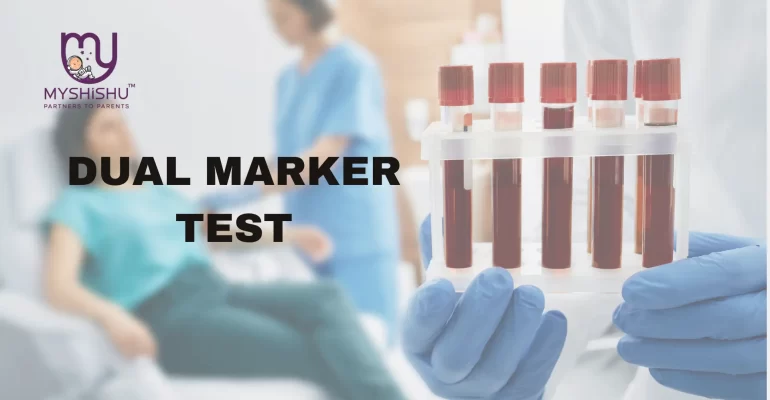Dual Marker Test in Pregnancy: A Reliable Guide
Dual Marker Test in Pregnancy: A Reliable Guide
Introduction
Welcome to a guide on the topic of dual marker test in pregnancy. As you embark on this incredible journey of pregnancy, filled with anticipation, joy, and perhaps a hint of nervousness, it’s natural to want the very best for your growing baby. Alongside the excitement of feeling those first kicks and imagining what your little one will look like, there may also be questions and uncertainties lingering in your mind about your baby’s health and development.
In the realm of prenatal care, there exists a myriad of tests and screenings designed to ensure the well-being of both mother and child. One such test that you may encounter during your pregnancy journey is the dual marker test in pregnancy. This screening holds significance as it provides valuable insights into potential chromosomal abnormalities in your developing baby.
In this blog, we’ll delve into the intricacies of the dual marker test in pregnancy, shedding light on what it entails, why it’s performed, and what you can expect during the process. As you navigate the maze of prenatal care options, remember that knowledge is power, and arming yourself with information can empower you to make informed decisions about your pregnancy and the health of your precious little one.
So, dear mothers-to-be, let’s embark on this enlightening journey together as we unravel the mysteries surrounding the dual marker test in pregnancy and discover how it can play a pivotal role in ensuring the health and happiness of you and your baby.
What is the Dual Marker Test in Pregnancy?
The dual marker test in pregnancy, also known as the double marker test, is a prenatal screening test performed during the first trimester of pregnancy, typically between 9 to 13 weeks. This test aims to assess the risk of certain chromosomal abnormalities in the developing fetus, particularly Down syndrome (Trisomy 21) and Edwards syndrome (Trisomy 18).
During the dual marker test in pregnancy, a small sample of maternal blood is collected, usually through a simple blood draw from a vein in the arm. The blood sample is then sent to a laboratory for analysis, where specific markers are measured.
The two primary markers analyzed in the dual marker test in pregnancy are:
- Pregnancy-associated plasma protein-A (PAPP-A): This protein is produced by the placenta during pregnancy. Abnormal levels of PAPP-A may indicate an increased risk of chromosomal abnormalities in the fetus.
- Human chorionic gonadotropin (hCG): This hormone is also produced by the placenta and plays a crucial role in maintaining pregnancy. Deviations from normal hCG levels may suggest a higher risk of chromosomal abnormalities.
By measuring these markers and assessing their levels in maternal blood, healthcare providers can estimate the likelihood of the fetus having chromosomal abnormalities. It’s important to note that the dual marker test in pregnancy is a screening test, not a diagnostic test. A positive result from the dual marker test indicates an increased risk of chromosomal abnormalities, but further diagnostic testing, such as chorionic villus sampling (CVS) or amniocentesis, may be required to confirm or rule out the presence of these conditions.
Overall, the dual marker test in pregnancy serves as a valuable tool in identifying pregnancies that may be at higher risk for chromosomal abnormalities, allowing expectant parents to make informed decisions about their pregnancy and access appropriate medical care and support.
Why is the Dual Marker Test Important?
The dual marker test in pregnancy holds significant importance in prenatal care for several reasons:
- Early Detection of Chromosomal Abnormalities: The test allows for the early detection of chromosomal abnormalities in the developing fetus, such as Down syndrome (Trisomy 21) and Edwards syndrome (Trisomy 18). Detecting these abnormalities early in pregnancy enables healthcare providers and expectant parents to make informed decisions regarding further diagnostic testing, pregnancy management, and planning for the future.
- Risk Assessment: By analyzing specific markers in maternal blood, such as pregnancy-associated plasma protein-A (PAPP-A) and human chorionic gonadotropin (hCG), the dual marker test provides a risk assessment for chromosomal abnormalities. This information helps healthcare providers stratify the risk level for individual pregnancies, guiding subsequent prenatal care and monitoring.
- Informed Decision-Making: Positive results from the dual marker test in pregnancy indicate an increased risk of chromosomal abnormalities in the fetus. Armed with this information, expectant parents can make informed decisions about their pregnancy, such as pursuing further diagnostic testing (e.g., chorionic villus sampling or amniocentesis), considering genetic counseling, or preparing for the potential challenges associated with a chromosomal abnormality.
- Psychological Preparation: For expectant parents who receive positive results from the dual marker test in pregnancy, having advance knowledge of a potential chromosomal abnormality allows for psychological preparation and adjustment. It provides an opportunity for parents to seek emotional support, connect with support groups, and access resources to navigate the challenges that may lie ahead.
- Optimal Pregnancy Management: In cases where chromosomal abnormalities are detected, early identification through the dual marker test in pregnancy allows healthcare providers to tailor pregnancy management and care accordingly. This may involve close monitoring of fetal development, coordination with specialists, and planning for specialized medical interventions or support services.
Overall, the dual marker test in pregnancy plays a crucial role in prenatal care by providing valuable insights into the risk of chromosomal abnormalities in the developing fetus. Its importance lies in enabling early detection, risk assessment, informed decision-making, psychological preparation, and optimal pregnancy management, ultimately contributing to the health and well-being of both mother and baby.
How is the Dual Marker Test Performed?
The dual marker test in pregnancy, also known as the double marker test, is a straightforward procedure performed during the first trimester of pregnancy, typically between 9 to 13 weeks gestation. Here’s a step-by-step overview of how the dual marker test in pregnancy is conducted:
- Consultation with Healthcare Provider: The process usually begins with a consultation with your healthcare provider, who will discuss the purpose of the dual marker test in pregnancy, its benefits, and any associated risks. During this consultation, your healthcare provider may also review your medical history, including any relevant risk factors or concerns.
- Blood Sample Collection: The actual test involves a simple blood draw, usually performed at a prenatal care clinic or laboratory. A trained healthcare professional will collect a small sample of your blood, typically from a vein in your arm. The procedure is similar to having blood drawn for routine laboratory tests and is relatively quick and painless.
- Laboratory Analysis: Once the blood sample is collected, it is sent to a laboratory for analysis. In the lab, the sample is processed to measure specific markers, such as pregnancy-associated plasma protein-A (PAPP-A) and human chorionic gonadotropin (hCG). These markers are then used to assess the risk of chromosomal abnormalities in the developing fetus.
- Interpretation of Results: After the laboratory analysis is complete, the results of the dual marker test in pregnancy are typically reported as a risk score or probability. A lower risk score suggests a lower likelihood of chromosomal abnormalities, while a higher risk score may indicate an increased risk. Your healthcare provider will interpret the results and discuss them with you in detail, explaining what they mean for your pregnancy and any further steps that may be recommended.
- Follow-Up Consultation: Depending on the results of the dual marker test in pregnancy, your healthcare provider may recommend additional testing or interventions, such as further diagnostic testing (e.g., chorionic villus sampling or amniocentesis) or genetic counseling. They will guide you through the next steps and provide support and information to help you make informed decisions about your pregnancy.
Overall, the dual marker test in pregnancy is a simple and important screening tool that provides valuable information about the risk of chromosomal abnormalities in the developing fetus. By undergoing dual marker test in pregnancy, expectant mothers can take proactive steps to ensure the health and well-being of themselves and their babies.

Interpreting the Results
Interpreting the results of the dual marker test in pregnancy involves understanding the risk assessment provided based on the measured markers in maternal blood. Here’s how the results are typically interpreted:
- Risk Score or Probability: The results of the dual marker test in pregnancy are reported as a risk score or probability, indicating the likelihood of the fetus having chromosomal abnormalities, such as Down syndrome (Trisomy 21) or Edwards syndrome (Trisomy 18). This risk score is expressed as a ratio or percentage.
- Lower Risk Score: A lower risk score suggests a lower likelihood of chromosomal abnormalities in the fetus. In many cases, a low-risk result provides reassurance to expectant parents that the likelihood of their baby having a chromosomal abnormality is minimal.
- Higher Risk Score: Conversely, a higher risk score indicates an increased likelihood of chromosomal abnormalities in the fetus. It’s important to note that a higher risk score from the dual marker test does not confirm the presence of chromosomal abnormalities; instead, it indicates the need for further diagnostic testing to confirm or rule out these conditions.
- Further Diagnostic Testing: If the results of the dual marker test indicate a higher risk of chromosomal abnormalities, your healthcare provider may recommend additional diagnostic tests, such as chorionic villus sampling (CVS) or amniocentesis. These tests can provide more definitive information about the genetic makeup of the fetus and help confirm or exclude the presence of chromosomal abnormalities.
- Genetic Counseling: Regardless of the test results, genetic counseling may be recommended for expectant parents to provide further information, support, and guidance. A genetic counselor can help interpret the results of the dual marker test, discuss the implications for the pregnancy, and assist in decision-making regarding further testing or pregnancy management.
It’s essential to remember that the dual marker test is a screening test, not a diagnostic test. While it can provide valuable information about the risk of chromosomal abnormalities in the fetus, further diagnostic testing may be necessary to confirm or rule out these conditions definitively.
Preparing for Dual Marker Test
Preparing for the dual marker test involves several steps to ensure that the procedure is conducted smoothly and effectively. Here’s what you can do to prepare for the test:
- Schedule an Appointment: Contact your healthcare provider or prenatal care clinic to schedule an appointment for the dual marker test. It’s essential to have the test performed within the recommended timeframe, typically between 9 to 13 weeks of pregnancy.
- Follow Any Specific Instructions: Your healthcare provider may provide you with specific instructions to follow before the test. These instructions may include guidelines on fasting (if required), medication use, or any dietary restrictions. It’s important to adhere to these instructions to ensure accurate test results.
- Stay Hydrated: Drinking plenty of water before the test can help make it easier to draw blood and ensure a smoother blood collection process. Aim to stay well-hydrated in the days leading up to the test.
- Bring Identification and Insurance Information: When you go for your appointment, be sure to bring your identification (such as a driver’s license or ID card) and any insurance information. This will facilitate the registration process and ensure that your test is properly documented for insurance purposes.
- Wear Comfortable Clothing: Choose loose-fitting and comfortable clothing for your appointment, as you may need to roll up your sleeves for the blood draw. Comfortable attire will also help you feel more relaxed during the procedure.
- Bring a Support Person: If you feel anxious about the test or would like emotional support, consider bringing a partner, family member, or friend with you to your appointment. Having a support person present can help alleviate anxiety and provide reassurance during the test.
- Prepare Questions: Take some time to prepare any questions you may have about the dual marker test or pregnancy in general. Your healthcare provider is there to support you and address any concerns or queries you may have.
By following these steps and adequately preparing for the dual marker test, you can help ensure that the procedure goes smoothly and that you receive accurate and reliable test results. Remember to discuss any concerns or questions you have with your healthcare provider, as they are there to support you throughout your pregnancy journey.
Additional Common Questions
-
Is the dual marker test mandatory during pregnancy?
No, the dual marker test is not mandatory. It is an optional screening test that some expectant mothers choose to undergo to assess the risk of certain chromosomal abnormalities in the fetus. However, your healthcare provider may recommend the test based on factors such as your age, medical history, or family history of genetic conditions.
-
How long does it take to get the results of the dual marker test?
The turnaround time for dual marker test results can vary depending on the laboratory where the test is performed. In general, you can expect to receive the results within a week or two after the blood sample is collected. Your healthcare provider will discuss the results with you once they are available.
-
Does a positive result from the dual marker test mean my baby definitely has a chromosomal abnormality?
No, a positive result from the dual marker test indicates an increased risk of chromosomal abnormalities in the fetus, but it does not confirm the presence of these conditions. Further diagnostic testing, such as chorionic villus sampling (CVS) or amniocentesis, may be recommended to confirm or rule out the presence of chromosomal abnormalities.
-
Are there any risks or side effects associated with the dual marker test?
The dual marker test is a relatively safe procedure with minimal risks. The most common side effect is discomfort or bruising at the site of the blood draw. Serious complications are rare but may include infection, bleeding, or fainting. Your healthcare provider will discuss any potential risks with you before the test.
-
Will insurance cover the cost of the dual marker test?
Coverage for the dual marker test varies depending on your insurance plan and provider. Some insurance plans may cover the cost of prenatal screening tests, including the dual marker test, while others may require you to pay out-of-pocket or have specific criteria for coverage. It’s essential to check with your insurance provider to understand your coverage options.
-
Can I refuse the dual marker test if I don’t want it?
Yes, the decision to undergo prenatal screening tests, including the dual marker test, is entirely voluntary. You have the right to refuse any medical procedure or test that you do not wish to undergo. However, it’s essential to discuss your decision with your healthcare provider so that you can make an informed choice about your prenatal care.
Conclusion
In conclusion, the dual marker test can provide valuable information about the risk of chromosomal abnormalities in the fetus, offering expectant mothers peace of mind and the opportunity for early intervention if needed. While the decision to undergo prenatal screening tests is personal, it’s essential to discuss your options with your healthcare provider to make informed choices about your pregnancy care. Remember, your healthcare team is here to support you every step of the way.

want to know more
Explore Our Courses











